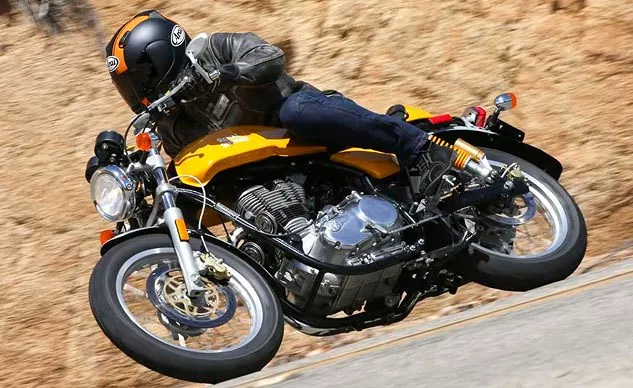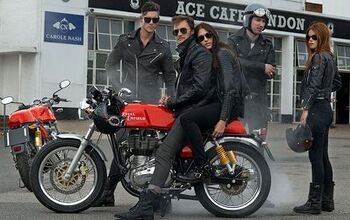Church Of MO: 2014 Royal Enfield Continental GT Review

A look back at one of MO's first experiences with Royal Enfield.
In case you haven't noticed, Royal Enfield is on the up and up. While it might not seem so in the US, globally (and primarily in its home country of India) sales are growing – and growing fast. So much so that the company is making a big push into the US and North American markets. So what better time to take a look back at one of MO's first experiences with a Royal Enfield – the Royal Enfield Continental GT from back in 2014. Astute readers or RE fans will already note that this is an old model, which doesn't share much with the current Continental GT. And that's a good thing, because as Tom Roderick tells us, the 2014 version was a bit rough around the edges.
2014 Royal Enfield Continental GT Review
by Tom Roderick
July 1st, 2014
Return of the single-cylinder cafe racer
In a world of increasing electronic complexity, Royal Enfield’s Continental GT is a bastion of motorcycling simplicity. And that’s just how Enfield’s CEO, Siddhartha Lal, likes it. Over lunch on our Continental GT media ride, he relates how the more simple a motorcycle is, the more reliable the bike and the easier it is to fix if there is a problem. No argument there, but what’s his underlying point?
2014 Royal Enfield Continental GT
Editor Score: 76.0%
Engine | 12.0/20 |
Suspension/Handling | 12.5/15 |
Transmission/Clutch | 8.75/10 |
Brakes | 7.75/10 |
Instruments/Controls | 4.0/5 |
Ergonomics/Comfort | 8.25/10 |
Appearance/Quality | 8.0/10 |
Desirability | 7.25/10 |
Value | 7.5/10 |
Overall Score | 76/100 |
Interview with Royal Enfield CEO Siddhartha Lal
Since 1955, Royal Enfields have been produced in a country with more unpaved than paved roads for a mostly rural population of more than a billion people. Simplicity and dependability (as well as self-reliance in one’s own mechanical skills) are therefore more than just valuable assets for Indian motorcyclists, they’re necessities for reliable, everyday transportation.
The new Continental GT comprises Enfield’s reputable attributes and puts them forth in a cafe racer package based on the company’s own Continental GT model first launched in 1964.
Unlike the 250cc Conti GT of yore, the modern counterpart is powered by a 535cc Unit Construction Engine (UCE). Introduced in 2009, the OHV, UCE has an undersquare bore and stroke of 87mm x 90mm and a compression ratio of 8.5:1. The result is a slow revving engine that produces a claimed 29.1 bhp at 5100 rpm and 32.5 ft-lb of torque at 4000 rpm.
Not exactly overwhelming power and torque figures which you can feel … er… not feel(?), when riding the GT. Lethargic probably bests describes the Conti GT’s engine performance, but it gets the job done.
Comparatively, in our 2013 Beginner Sportbike Shootout Part 2 we measured Honda’s CBR500R and found that it produced 42.9 hp at 8600 rpm and 28.6 ft-lb of torque at 6500 rpm. The Honda’s 471cc parallel-Twin suffers a 64cc displacement disadvantage but boasts liquid-cooling, DOHC and four valves per cylinder. The CBR, at $6299, costs $300 more than the Conti. Considering this engine power disparity, maybe a Ninja 300, with a measured 34.8 hp @ 10,600 rpm and 18.0 ft-lbs of torque @ 9600 rpm (from our 2013 Beginner Sportbike Shootout Part 1) would be a more appropriate choice for a model comparison.
Riding a red GT reveals not a buzz, but a big-cylinder thump that palpitates through the seat, bars and footpegs. It wasn’t until switching from the red to a yellow GT that the vibration changed from noticeable to obnoxious, primarily through the handlebars. While vibrations through the seat and pegs remained equitable between the two bikes, the handlebar vibes on the yellow model had my metacarpals feeling as though they may burst through the skin. Certainly, the color of bike has nothing to do with differing engine vibration, but it raises a question about production consistency. Equipping the engine with a counter-balancer would go a long way in minimizing vibes regardless what color or model Enfield you’re riding.
With a claimed curb weight of 406 pounds (90% of fuel tank capacity), the Conti certainly isn’t a heavy motorcycle, and its lowish, 31.5-inch seat height makes managing that weight easier at stops and slower speeds. New-to-intermediate riders, or those of restricted inseam length, will appreciate these facets.
2013 Moto Guzzi V7 Racer Vs. 2013 Triumph Thruxton – Video
Riding on 18-inch wheels (100/90 front and 130/70 rear), stability’s more the name of the game than is quick transitioning. But that doesn’t stop an Enfield rider from enjoying a set of switchbacks. Just keep your momentum up and go lightly on the single-disc front brake, because powering strongly out of corners really isn’t an option. The Pirelli Sport Demon tires provide ample grip and, being a sport-touring tire, should also rack up plenty miles before needing to be replaced. When it does come time to replace tires, a set of the same rubber should only set you back about $200.
The double-cradle, steel “featherbed” frame combined with the non-adjustable fork and preload-adjustable shock kept the GT from exhibiting any unnecessary or surprising reactions when navigating corners at the speeds we were riding. The suspension registers on the stiffer side of compliant; helpful when going fast, a little abrupt over the bumps when going slow.
Whether going fast or slow, the raspy thumperspeak emanating from the chrome muffler is an aggressive roar for an OEM pipe. Our group of 20 or so bikes sounded like a gang of Africanized bees on steroids echoing off the canyon walls of San Diego county.
The rider triangle is surprisingly more comfortable than the bike’s profile implies. For my 5’ 11” frame there was no discernable leg/knee cramping, and the reach to the bars is aided by the fact that the clip-ons are mounted above the triple clamp. Seat foam leaves something to be desired as it compresses after a short while with 185 pounds of pressure upon it, providing the rider (me) without all-day cushioning.
Overall build quality, paint, attention to detail, etc., seemed, for the most part, up to the standards of comparable Japanese models, and certainly better than some of the bargain bikes from some Asian brands we’ve tested before but won’t name here. The machined, bar-end mirrors are exceptionally attractive, but vibrations kept knocking them out of adjustment.
Speaking of Royal Enfield’s competitors, now that the company is making a push to increase recognition of the Royal Enfield brand in the US – better availability to models for both consumers and the press – we’ll be including Enfields in future comparison tests.
+ Highs
- Café racer with a two-year warranty
- A reputedly reliable motorcycle
- A customizer’s or home mechanic’s dream
– Sighs
- Underpowered
- Questionable production consistency
- Not quite the value it should be
2014 Royal Enfield Continental GT Specs | |
MSRP | $5999 |
Horsepower (claimed) | 29.1 bhp @ 5100 rpm |
Torque (claimed) | 32.5 ft-lbs @ 4000 rpm |
Engine Capacity | 535cc |
Engine Type | Air-cooled, OHV, two-valve, Single |
Bore x Stroke | 87mm x 90mm |
Compression | 8.5:1 |
Fuel System | EFI |
Transmission | 5-speed |
Clutch | Wet, multi-plate |
Final Drive | Chain |
Frame | Steel, double-cradle |
Front Suspension | Telescopic, 41mm fork, 110mm travel |
Rear Suspension | Paioli, twin gas charged shock absorbers with adjustable preload, 80mm travel |
Front Brakes | 300mm disc with two-piston caliper |
Rear Brakes | 240mm disc with single-piston caliper |
Front Tire | 100/90-18 |
Rear Tire | 130/70-18 |
Seat Height | 31.5 inches |
Wheelbase | 53.5 inches |
Curb Weight (claimed) | 406 pounds (90% of fuel tank capacity) |
Fuel Capacity | 3.6 gal |
Colors | Red, Yellow |
Warranty | Two years unlimited miles |
Become a Motorcycle.com insider. Get the latest motorcycle news first by subscribing to our newsletter here.

Troy's been riding motorcycles and writing about them since 2006, getting his start at Rider Magazine. From there, he moved to Sport Rider Magazine before finally landing at Motorcycle.com in 2011. A lifelong gearhead who didn't fully immerse himself in motorcycles until his teenage years, Troy's interests have always been in technology, performance, and going fast. Naturally, racing was the perfect avenue to combine all three. Troy has been racing nearly as long as he's been riding and has competed at the AMA national level. He's also won multiple club races throughout the country, culminating in a Utah Sport Bike Association championship in 2011. He has been invited as a guest instructor for the Yamaha Champions Riding School, and when he's not out riding, he's either wrenching on bikes or watching MotoGP.
More by Troy Siahaan



































Comments
Join the conversation